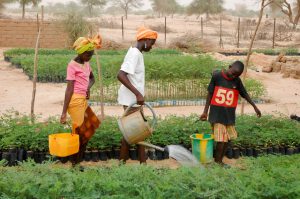by Rita Brhel
I live in the middle of America’s heartland — Nebraska — surrounded by a sea of corn and soybean fields, most of which are irrigated for the entire growing season. Even the crops that aren’t irrigated still yield enough to provide the farmer with ample income to live on.
I live atop one of the largest underground caches of water in the world. The Ogallala Aquifer stretches from the South Dakota-Nebraska border south through the Texas Panhandle, running under seven U.S. states. We have no shortage of water here, not for community use and not for farming. My hometown, Hastings, sees an average annual rainfall of 28 inches with an additional average annual snowfall of 29 inches. I have never known what it’s like to not have easy access to abundant, clean water.
My husband, however, has. He grew up in the southeastern portion of Nebraska, which does not have access to the aquifer. There, on a cattle farm, his family had to time their use of water — whether for drinking or bathing or washing dishes — between when the cows came to the barn to get water. There was not enough water in their well to provide for all the needs in their house.
Yet, my husband’s family still knew more water most people in Niger do. My husband’s hometown, Lincoln, sees an average annual rainfall of nearly 29 inches with an additional average annual snowfall of 26 inches. While southwestern Niger may receive up to 23 inches of precipitation during the May-to-September rainy season, northern Niger sees an average annual rainfall of just 7 inches and the desert regions of Eastern Niger are lucky to get 3/4 of an inch of rain a year.
The only place in the United States with a comparable lack of rainfall is Death Valley in California, which sees an average annual rainfall of 2 inches. Even the driest U.S. state, Nevada, sees more precipitation than Niger at 9-1/2 inches of rainfall each year.
As if that’s not enough, severe droughts regularly hit the country, causing serious, life-taking famines.
We, Americans, simply cannot even imagine what it’s like to live in Niger — it’s not just dry, but most people there have to walk for hours a day to find water, which is often contaminated. When each day’s goal is just to survive and there is often not enough water to meet the human consumption needs, it’s not feasible to reserve water for irrigation. But this only creates a self-perpetuating cycle — no access to clean water…widespread water-borne illness…just surviving day-to-day…no water for food crops…famines…hunger and death…disempowered people continuing to drink and use unclean water…repeat.
By drilling a well, Wells Bring Hope breaks this cycle. Water-borne disease is eliminated. There is enough grey water left over from baths and utensil cleaning to use drip-irrigation for village gardens. This allows villagers to, grow not only enough food for themselves, but also enough o trade or sell to others for a profit. Families ,and by extension entire communities are empowered and the cycle of poverty is forever interrupted. In short, lives are transformed.

Help Wells Bring Hope to bring more hope to communities in Niger. Every cent raised goes toward drilling a well, and every dollar raised is matched by World Vision to provide sanitation and hygiene education, micro-entrepreneurship training, and community building. What you donate today will grow exponentially over the next fifteen years.
Start a Water Circle today to change a village of lives tomorrow.


